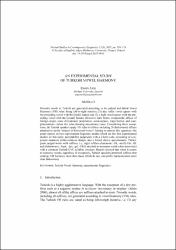| dc.contributor.author | Arık, Engin | |
| dc.date.accessioned | 10.07.201910:49:13 | |
| dc.date.accessioned | 2019-07-10T20:02:38Z | |
| dc.date.available | 10.07.201910:49:13 | |
| dc.date.available | 2019-07-10T20:02:38Z | |
| dc.date.issued | 2015 | en_US |
| dc.identifier.citation | Arık, E. (2015). An experimental study of Turkish vowel harmony. Poznan Studies in Contemporary Linguistics, 51(3), 359-374. https://dx.doi.org/10.1515/psicl-2015-0014 | en_US |
| dc.identifier.issn | 1897-7499 | |
| dc.identifier.uri | https://dx.doi.org/10.1515/psicl-2015-0014 | |
| dc.identifier.uri | https://hdl.handle.net/20.500.12511/3699 | |
| dc.description | WOS: 000367321300001 | en_US |
| dc.description.abstract | Prosodic words in Turkish are generated according to the palatal and labial Vowel Harmony (VH) rules: being left-to-right iterative, (1) any suffix vowel agrees with the preceding vowel with the [back] feature and (2) a high vowel agrees with the preceding vowel with the [round] feature. However, bare forms, compounds, affixes of foreign origin, some derivational morphemes, semi-copulas, imperfective, and complementizers violate the rules forming exceptional cases. Considering these exceptions, do Turkish speakers apply VH rules to affixes including 28 disharmonic affixes attached to newly formed or borrowed words? Aiming to answer this question, this paper reports on two experimental linguistic studies which are the first experimental studies on this topic: acceptability judgments with a Likert scale, consisting of a repeated measures within-subjects design, and a forced choice questionnaire. Participants judged words with suffixes, i.e., eight suffixes (harmonic: -DI, -mAlI,-lAr, -lIk and disharmonic: -lejin, -Ijor, -gil, -Ebil) attached to nonsense words (also nonwords) with a common Turkish CVC syllable structure. Results showed that when it comes to nonsense words, regardless of exceptions, Turkish speakers preferred suffixes that undergo VH harmony more than those which do not, and prefer harmonization more than disharmony. | en_US |
| dc.language.iso | eng | en_US |
| dc.publisher | Polish Academy of Science, Committee of Physical Culture | en_US |
| dc.rights | info:eu-repo/semantics/openAccess | en_US |
| dc.subject | Turkish Vowel Harmony | en_US |
| dc.subject | Experimental Linguistics | en_US |
| dc.title | An experimental study of Turkish vowel harmony | en_US |
| dc.type | article | en_US |
| dc.relation.ispartof | Poznan Studies in Contemporary Linguistics | en_US |
| dc.department | İstanbul Medipol Üniversitesi, İnsan ve Toplum Bilimleri Fakültesi, Psikoloji Bölümü | en_US |
| dc.authorid | 0000-0002-0981-257X | en_US |
| dc.identifier.volume | 51 | en_US |
| dc.identifier.issue | 3 | en_US |
| dc.identifier.startpage | 359 | en_US |
| dc.identifier.endpage | 374 | en_US |
| dc.relation.publicationcategory | Makale - Uluslararası Hakemli Dergi - Kurum Öğretim Elemanı | en_US |
| dc.identifier.doi | 10.1515/psicl-2015-0014 | en_US |
| dc.identifier.wosquality | Q4 | en_US |
| dc.identifier.scopusquality | Q2 | en_US |


















